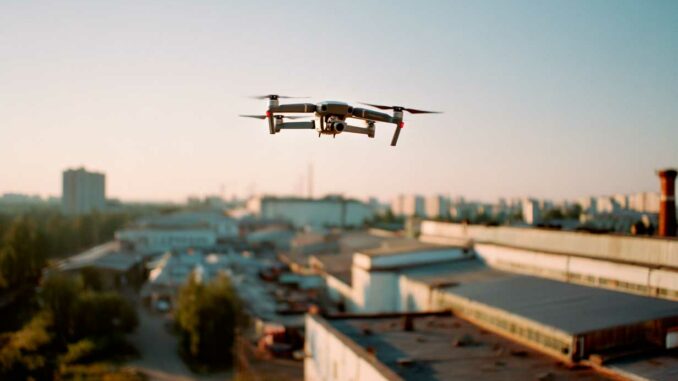
Tech players such as Palantir and Anduril are challenging traditional defense giants and calling for a overhaul of the US military industrial base.
In summary
A strategic debate is intensifying in the US between West Coast tech startups such as Palantir and Anduril and historic defense giants such as Lockheed Martin and Northrop Grumman. These new entrants denounce the slow pace of innovation and the priority given to dividends in large corporations, which they consider ill-suited to the current geopolitical environment marked by the war in Ukraine, rivalry with China, and tensions in the Middle East.
In a manifesto entitled The Defense Reformation, Shyam Sankar, Palantir’s chief technology officer, calls for a renaissance of the American industrial base, placing software at the heart of military power. This divide reveals deep differences over the role of the federal government, budget priorities, and how to prepare the U.S. military for high-intensity conflict.
The geopolitical context and Silicon Valley’s warning
Shyam Sankar’s comments come amid a tense international climate. Russia’s invasion of Ukraine, Iranian attacks on US bases, tensions in the South China Sea, and the October 7 attack in Israel are, in his view, symptoms of a “hot Cold War.”
This leader believes that the American system is no longer capable of producing enough ships, submarines, ammunition, and aircraft to respond to a major crisis. He attributes this vulnerability to the current structure of American capitalism, which he considers to be dominated by the pursuit of financial profitability at the expense of technical innovation.
This criticism is aimed directly at the major defense contractors—the “prime contractors”—including Lockheed Martin, Northrop Grumman, and Raytheon. Sankar accuses them of being run by teams more focused on financial management than on engineering and industrial capacity development. In his public statements, he emphasizes that the Department of Defense subsidizes private companies that lack both the efficiency of a planned economy and the dynamism of a truly competitive market.
This position reveals an ideological shift: some of Silicon Valley’s technological elite believe that the threat to American security stems less from a lack of funding than from the industrial governance structure and the inertia of traditional suppliers.
The rise of new tech players
Palantir, founded in 2003 by Peter Thiel, first made its mark in big data analysis for intelligence and security services. Its Gotham software has been used in the fight against terrorism and in the logistical tracking of armed forces. The company capitalized on this expertise to offer tactical data fusion platforms designed to improve decision-making on the battlefield.
For its part, Anduril Industries, founded in 2017 by Palmer Luckey, has chosen to develop software-centric military hardware, such as the Anvil interceptor drone, autonomous surveillance towers, and the Lattice operations system, capable of coordinating swarms of drones. The company emphasizes rapid development cycles and a production model similar to that of the civilian technology sector.
These companies criticize the bureaucratic red tape of traditional procurement procedures and promote an iterative approach, where systems are tested and improved quickly, even if it means accepting a higher initial failure rate. They argue that the military power of the future lies in software: artificial intelligence, robotics, logistics optimization, and massive data processing.
The heart of the debate: reindustrialization and the role of the state
In his manifesto, Sankar argues that the real challenge is not just the budget, but industrial capacity: producing sufficient quantities of weapons systems quickly. He laments that recent reindustrialization initiatives such as the CHIPS Act and the Inflation Reduction Act — whose combined cost remains less than half of the annual US defense budget, or around €430 billion — have not solved the problem of dependence on foreign supply chains or the sluggishness of large defense contractors.
This criticism highlights a dilemma: large companies have the infrastructure and expertise to manufacture complex systems such as fighter jets and submarines, but they are considered too slow and too focused on profitability to support a rapid mobilization effort.
Silicon Valley advocates believe that innovation must come from smaller, more agile companies, supported by more flexible government contracts and closer partnerships with the armed forces. However, this vision assumes that the government will agree to review its certification, risk management, and security processes, which raises questions about industrial sovereignty and software supply chain security.

Financial challenges and the effectiveness of the proposed model
The US defense budget reached nearly $850 billion in 2024, a significant portion of which is absorbed by the maintenance and renewal of existing programs. Proponents of change believe that this budget structure limits the scope for financing innovative projects and favors the status quo of large manufacturers.
Sankar and his allies are calling on the government to direct more funding towards software and autonomous solutions, which are less expensive to mass produce. They point out that autonomous drone systems can be manufactured for a few hundred thousand euros each, compared to tens of millions for a modern fighter jet.
This approach promises a more favorable cost-effectiveness ratio for attrition warfare scenarios, such as in Ukraine, where equipment consumption is massive and continuous. However, it requires reliable infrastructure for cyber defense, maintenance, and operator training, as well as an industrial network capable of rapidly producing advanced electronic components, an area in which the United States remains partially dependent on Asian imports.
The consequences for the American industrial and strategic balance
The challenge led by Palantir and Anduril could change the structure of the American military-industrial complex, historically dominated by a few large contractors. If Sankar’s ideas prevail, a larger share of future programs would be entrusted to digital players, reducing the weight of “bonuses.”
Such a development would strengthen the technological responsiveness of the US armed forces and their ability to rapidly integrate new solutions in artificial intelligence, robotics, and swarm warfare. But it would also create tensions: traditional manufacturers have considerable political influence, linked to employment and subcontracting chains in several key states.
Internationally, the adoption of a more agile model by the United States would widen the gap with European countries, whose procurement processes are often slower and more centralized. It could also increase allies’ dependence on American technologies, complicating cooperative projects such as the Franco-German-Spanish SCAF/FCAS.
A rivalry that will shape the future of defense
The debate opened by The Defense Reformation illustrates a sea change in American strategic culture. It is not just a matter of replacing equipment, but of rethinking the role of private innovation and the relationship between the state and industry in preparing for war.
If Silicon Valley succeeds in convincing the Pentagon to adopt its approach, the US military could benefit from faster technology cycles and more flexible adaptation to threats. If, on the contrary, the current system persists, there is a risk of seeing a widening gap between the volume of equipment needed in a prolonged conflict and actual production capabilities.
The issue goes beyond rivalry between companies: it raises the question of the resilience of the industrial base of democracies in the face of adversaries capable of rapidly mobilizing their national resources. The choices made in the coming years will determine the United States’ ability to remain the driving force behind Western defense innovation.
War Wings Daily is an independant magazine.